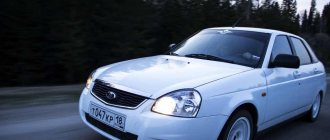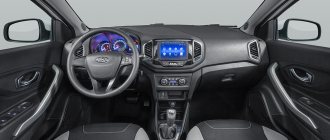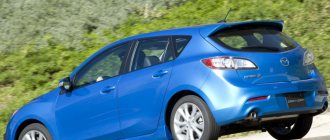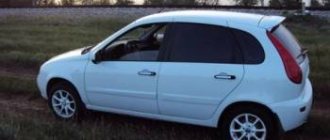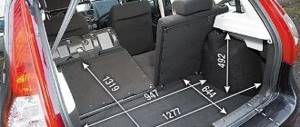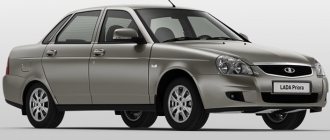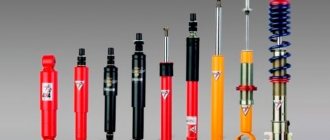October 28, 2015 Lada.Online 19 857 3
Currently, buyers of budget cars are faced with a difficult choice. The market offers at a low price the domestic car Lada Granta, the main competitor of which is a foreign car - the new Renault Logan 2 (manufactured since 2013). Let's determine which car is best to consider buying and why..
About the advantages of Lada Granta - sedan
The inherent popularity of this modification of the Lada Granta is indicated by:
- versatility, because the sedan is characterized by the practicality of a “workhorse” and applicability to the status of a family car for various types of trips;
- a wide range of configuration options: from the cheapest “Standard” to the comfortable and sophisticated “Lux”;
- enviable ground clearance (160 mm), which allows you to overcome minor off-road conditions;
- spacious interior that can comfortably accommodate adult passengers;
- practical interior decoration;
- spacious luggage compartment, in addition to which the manufacturer has equipped the car with a full-fledged spare tire.
Currently, the indicated qualities of the Lada Granta car are among the most valuable and advantageous aspects for the owner in comparison with the not very elegant exterior. This inclines many customers to choose a sedan; many believe that a sedan is better. They even sacrifice the more beautiful design of the Lada Granta liftback in order to get a significantly lower price for the car and its availability in terms of maintenance activities.
Advantages and disadvantages of the hatchback body
Compact city hatchback
The main advantages of a hatchback include its size. Having a short rear overhang and overall short length, it lays claim to being a city dweller more than others. Also, this option, like no other, is suitable for novice drivers, who, with the size of a hatchback, will find it easier to get used to the dimensions of the car. The next advantage worth noting is the trunk, the opening of which is wider than that of the sedan. This allows you to load larger items, up to a washing machine or something similar.
And the disadvantages of the hatchback body include the absence of a partition between the passenger compartment and the luggage compartment, which negatively affects the operation of the car. Extraneous sounds from things rolling around in the trunk and the smell from them can cause considerable discomfort. Due to the absence of a partition, the volume of air in the cabin increases, which leads to a longer warm-up of the car in winter. And in the event of an accident, loose luggage items can injure passengers.
However, in comparison with the main opponent in the market, i.e. sedan, the hatchback looks less solid and representative, and this is not their only difference. And even more important, the luggage compartment in the sedan will not disturb passengers in any way while driving. But if we compare the hatchback with the familiar station wagon, then our “small” body has a couple of significant “FOR”, such as lower cost (again due to the size) and a more harmonious appearance. If you compare this type of car with a coupe, it becomes obvious that the hatchback has more luggage space and space in the cabin for rear passengers. Therefore, in comparison with any type of body, it has both pros and cons. But then we will take an even more detailed look at the hatchback, or rather at its descendant.
The importance of the liftback body
The release of the Lada Granta liftback modification became the primary project for AvtoVAZ in terms of applying foreign experience in the production of several body styles.
But did the manufacturer really limit himself to body modifications only, or did the modernization affect the interior and driving performance? To understand which is better, the versions must be compared, and probably then the question of which to choose will disappear by itself.
Vesta or Granta which is better
Kalina 2 station wagon or Granta liftback which is better
Grant speed sensor
Dimensions, appearance
The overall dimensions of the liftback differ from the sedan only in several respects. The main difference is the slightly reduced body length. For the hatchback, this parameter is 4.246 m, which is only 14 mm less than the sedan.
Parameters such as width and height remained unchanged; the sedan and hatchback are equal in these parameters and are 1.7 and 1.5 m, respectively. But in terms of ground clearance, the liftback wins with its 185 mm, versus the sedan’s 160 mm.
The front part of the Lada Granta liftback is not much different from the sedan. The same shapes of the hood, radiator grille and headlights. The only difference may be the front bumper. It has a slightly different shape of the air intake, and also acquired black inserts that house the fog lights. This is where the differences in the front end end.
If we compare these two versions of Grant from the side view, we can safely admit that the liftback looks much better than the sedan. The help of our French colleagues from Reno is making a difference. The hatchback has smooth transitions from the roof to the rear, which the sedan lacked. In addition to changing the shape of the rear body, several more changes have been added to the appearance of this part of the body.
Design changes and liftback auxiliary options
The new look of the LADA Granta Liftback gives it an undeniable brightness, but the sedan against its background looks a little dull and boring. For many, this is already an indicator of what to choose.
- A distinctive feature in comparison with the sedan is the color of the bumpers in body color.
- Minor changes affected the front bumper, where modified recesses appeared. This helped give the exterior a certain modernity. Otherwise, the appearance of the front end is identical to the sedan. Built-in niches for fog optics, which have a distinctive design, added a little charm.
- The contours of the exterior mirrors have acquired their own style and originality, which in turn adds an aerodynamic flair. Turn signal repeaters are also integrated into their housings.
- Moving the license plate to the lower edge of the rear door allowed the developers to place a fog light in the niche vacated on the bumper.
- The angle of inclination of the pillars and glass of the stern contributed to improved aerodynamic properties. The sloping shape allows the glass to not need to be cleaned for a long time, which eliminates the need for a rear wiper. This concept was first implemented in AZLK models.
- The shape of the rear headlights has become narrow, but in general terms it repeats the optics of the rear of the sedan.
If we compare, the design of the front door panels of the LADA Granta Liftback contains limiters that allow the effect of closers to be achieved at the moment of closing. The manufacturer also added an innovative seal. This solution led to the elimination of the creaking effect when unlocking the door and the elimination of glass rattling that occurred in the sedan.
Liftback characteristics
The name of this type of car is a composite of two English words: lift - to raise and back - rear part. In some sources the name “liftback” is found. This type is included in the group of passenger cars and has a visual similarity to both sedans and hatchbacks.
The liftback is classified as a two-volume body type because its interior is combined with a luggage area. However, the space dimensions for suitcases and bags are larger here than in a similar hatchback class. This is due to the increased overhangs at the rear, which also add internal volume.
You can notice the difference between a hatchback and a liftback when viewed from the side. The second car has a small step on the rear side, located almost immediately after the end of the rear glass. This quality adds resemblance to sedans.
The main global market where the liftback body is popular is North America. Overseas motorists have been maintaining the demand for such cars for a long time.
It is important to know that recently three-volume liftbacks have begun to appear on the market, in which the designers manage to isolate the luggage part.
The advantages of this version of passenger cars include:
- capacity;
- external parameters are close to classic dimensions;
- suitable for family trips.
The classic Soviet liftback is usually called the IZH-Combi. Modern representatives are Seat Toledo, Lada Granta Liftback, BMW 5-series GT, Skoda Oktavia, Skoda Superb. The Superba uses a type of trunk - Twindor, which is a double door.
Transformations affecting the chassis and body components
The manufacturer made every effort to eradicate the flaws inherent in the sedan.
The Lada Granta configurations in the “Standard” and “Norma” versions have acquired new settings in the suspension, where a special role is given to modified shock absorbers. The springs were carried over from the sedan. The suspension has become more suitable for country roads. Here passengers perceive bumps and potholes more comfortably.
The luxury equipment will delight you with a new suspension design, where a powerful stabilizer and rigid spring elements are located as a separate link. This solution is aimed at increasing stability and reducing amplitude during rolls.
Also, you should not ignore the gas-filled shock absorbers, which were previously equipped exclusively with LADA sports cars. The brake unit has increased responsiveness and information content due to the use of an updated vacuum booster.
The ground clearance has increased by 15mm, which will be especially gratifying for those who like to conquer off-road terrain.
If we compare, the design of the liftback does not imply the presence of a body-strengthening bulkhead located in the stern. The rigidity of the body frame was increased by strengthening the underbody and roof panel, as well as making adjustments to the design of the middle spar.
Modernization of equipment
The question of what to choose is relevant, so it’s worth fully understanding what’s what. The liftback will please you with a more diverse version in terms of configuration, including the pleasant presence of the following options:
- immobilizer;
- seat belt indicator;
- hydrocorrector of headlights;
- play an audible warning if the key is left in the ignition.
Fastening elements, which in the sedan tended to quickly corrode and collapse, are replaced here with more durable analogues with improved corrosion resistance.
Difference between a sedan and a hatchback
We found out the characteristics of the sedan and hatchback body. Now let’s figure out how they differ and what advantages they have.
- Machine length
. The hatchback is 30-40 centimeters smaller due to the shortened rear overhang. This affects maneuverability and makes parking much easier. This is important in a city where every inch of parking space counts. - Weight distribution along axles
. The sedan has the advantage of an evenly distributed weight load on the wheels. - Rear overhang
. In the hatchback it is shortened and thanks to this it is easier to park it in reverse without fear of hitting the curb. Due to road spray, the hatchback requires a rear windshield wiper and washer. - Cabin volume
. For this parameter, the sedan gets a plus, since it has a more comfortable interior for passengers. And although its competitor has a larger interior due to the trunk, it is not as comfortable. Moreover, to create a suitable microclimate in a hatchback, it will take more time to heat the interior or, conversely, to cool it. - Trunk volume
. It's hard to say who wins. The volume of the trunk itself is larger in the sedan. But in a hatchback, the passenger seats can be folded down to provide additional space. At the same time, the usable space is comparable, but loading, for example, a TV or long objects, in a sedan is difficult. The hatchback also makes the large loading window practical. - Safety
. The sedan clearly wins, since in the event of an accident, depressurization of the rear passenger compartment is almost impossible. In a collision, hatchback passengers are often injured by objects that were in the trunk. Some countries even require the use of a special dividing net. - Body connection
. It is difficult to say which side has the advantage; rather, it depends on the situation. Advantages of the connected interior and trunk space:
- access to luggage without leaving the car;
- in an unusual situation, it is possible to get into the car through the back door;
- increasing trunk volume at the expense of the interior.
Positive aspects of an insulated trunk:
- When transporting a canister of fuel or an open can of paint, you will not smell it and it will not affect your well-being.
- By opening the trunk, you do not change the microclimate inside the car.
- It's safer to transport small items.
- Ease of management
. In a hatchback, the border of the car body runs along the edge of the rear wheels, this allows the driver to better feel the dimensions of the car. Almost all sedan models have low ground clearance, which does not allow you to drive freely on dirt roads or broken asphalt. - Rear view
. Novice car enthusiasts will note that it is wider in the sedan. This is achieved as a result of the large rear window and short distance to the driver. In a hatchback, this distance is greater, and the glass itself is smaller, thus creating a tunnel effect or a reduced viewing angle. - Appearance
. The sedan has a more solid, presentable appearance. A hatchback is closer to a sports car.
Comparative technical parameters of the sedan and liftback
Next, we will perform an enlarged comparison of the technical aspects of these modifications of LADA Granta in order to provide greater clarity.
- The engine displacement of both versions is identical and is 1.6 liters.
- Gas tanks have the same volume in terms of capacity, 50 liters each.
- In terms of luggage compartment capacity, the leader is the sedan with a value of 530 liters, while the liftback can only offer 440 liters of free space for luggage. If the latter folds down the rear backrests, the trunk will increase to 760 liters.
- If in terms of maximum speed the sedan is ahead: 182 km per hour versus 179, then in terms of dynamic capabilities the liftback is already on the pedestal (12.3 seconds to a hundred versus 14.2 seconds).
- The modifications are equipped with 8-valve engines in the LADA Granta sedan and more advanced units with 16-valve timing mechanisms. Both engines have the same displacement of 1.6 liters. The engine option with 8 valves will please you with its design simplicity and, therefore, cheaper maintenance. But for the 16-valve unit, higher levels of speed, power and dynamics are available.
Station wagon: I take everything I own with me!
The station wagon is a five-door passenger car based on a sedan of the same model, in which 4 doors are located on the sides in pairs, and one in the rear of the body. The latter is located vertically and is the lid of the luggage compartment, which communicates with the interior of the car.
If necessary, the luggage compartment volume can be increased by folding the rear row of seats (the same as in the hatchback we discussed above).
Of all types of passenger cars, station wagons are best suited for cargo transportation, which is why they have been consistently popular for many years among people working with large luggage.
The disadvantages of the class, as a rule, include increased injuries among passengers as a result of an accident. In the event of a collision, cargo from the trunk may fly into the cabin. In some countries, traffic regulations require the use of a special dividing grid that protects people from force majeure situations.
Price
The minimum equipment level of the liftback is rated higher than the “Standard” version found in the sedan. More specifically, you will have to pay 314.8 thousand rubles for the liftback. Whether it is rational to overpay for the improvements indicated here is up to the buyer to decide.
The manufacturer plans to equip the sedan with the options present in the liftback in the near future. The restyling process for the LADA Granta is expected to be carried out this year. Today, the liftback has a number of undeniable advantages over the sedan regarding the exterior and driving parameters, but still, which is better, everyone chooses for themselves. When choosing a suitable modification, you should first study the full list of features. It is also not recommended to neglect your own priorities and preferences. Consider the difference between modifications not only in characteristics and equipment, but also in a financial sense. If you are willing to pay more for a presentable design, interior improvements and slightly increased performance, then the liftback is your option. But in fairness, we note that today the liftback is brighter and more balanced in comparison with the sedan, and this allows us to mark it as the leader of our review.
Body differences
Undoubtedly, two body types belong to the class of passenger cars. In terms of their properties and characteristics, they are equivalent to sedans. Now let's compare them:
- The liftback is very sedan-like due to its relatively long rear overhang;
- The hatchback has a one-volume body, i.e. the luggage compartment and interior are combined into one whole space;
- the liftback has a couple of versions for opening the rear door;
- Almost all liftbacks are two-volume, but there are also three-volume ones. *in addition, read the article "".
These are the main differences that can be distinguished between these types of bodies.
The differences, as it turned out, are very serious and now you definitely won’t confuse them with each other. In this article, we found out how a liftback differs from a hatchback, what is the difference between these bodies. If a hatchback can be immediately identified, then with a liftback this situation is less simple compared to a sedan. Nevertheless, as a separate type of liftback body it is very difficult to distinguish; most people will classify it as one or another more common type of body.
Over the past decades, the domestic market has been filled with a huge number of cars that cannot always be confidently classified. Understanding the products of the modern automobile industry can be difficult for non-specialists. Therefore, we have prepared for our readers an article-review of two popular types of passenger car bodies: liftback and hatchback.
So, what is the difference between a liftback and a hatchback and what are their advantages over conventional sedans? For what purposes were these bodies developed? We answer the most frequently asked questions in this post.
In conditions of dense city traffic, increased demands are placed on the car - it must combine comfort and maneuverability.
Sedans, which practically reigned supreme on the roads of big cities in the 20th century, do not always meet the needs of modern drivers. In particular, due to their length, it can be inconvenient to park along the road and move in heavy traffic from lane to lane.
The solution was found by radically changing the car configuration:
- the luggage section was combined with the cabin;
- the rear overhang has been significantly shortened;
- A front-wheel drive system with a transversely mounted engine became standard.
New cars acquired the name hatchback ( eng.
hatch = hatch) thanks to an innovative design with a rear door through which access to the luggage compartment was provided. Today, cars of this type are produced in both 5-door and 3-door configurations, and are popular among Russian motorists.
Separately, it is worth noting that such models are much better than a sedan for novice drivers, since they are easier to get used to the dimensions. If you are choosing your first car, then this is your choice.
Unfortunately, hatchbacks have some disadvantages that owners need to take into account - in the event of an accident, the contents of the trunk can “fly” into the cabin and injure passengers sitting in the rear seats. A special mesh covering the cargo compartment will help prevent accidents. In addition, keep in mind that unpleasant odors from luggage can also lead to serious discomfort during long rides.
